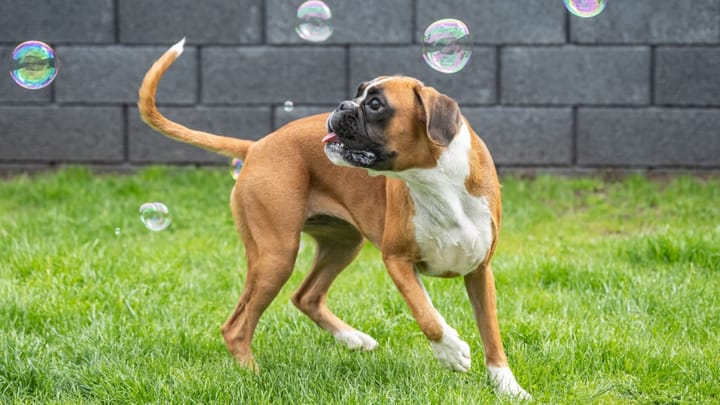Boxer
Other names : German Boxer, Deutscher Boxer


Boxers are active dogs who make wonderful watchdogs and family companions. Considered one of the best babysitters of their species, they love children. Boxers make wonderful additions to active families. They'll take great joy in joining you on hikes or runs; especially since they don't like being left alone too much.
|
Life expectancy |
The Boxer has a life expectancy of between 9 and 11 years |
|
Temperament |
|
|
Size |
Medium
|
|
Adult size |
Female
Between 21 and 23 in
Male
Between 22 and 25 in
|
|
Adult weight |
Female
Between 53 and 71 lb
Male
Between 66 and 84 lb
|
|
Coat colour
The coat can be fawn or brindle. White patching is admissible on condition that they constitute less than a third of the overall base colour. White Boxers- which have more substantial and dominating white patching- do exist. They are recognised by the FCI but are not recognised by the Kennel Club. There are also black Boxers, but more often than not, they quite simply are a very dark brindle. |
Brown Sand |
|
Type of coat
The coat is very short. The coat is coarse, shiny, and close-lying. |
Very short |
|
Eye colour
The eyes are very dark. |
Brown
|
|
Purchase price |
The Boxer costs between £970 and £1130 |
Since it is a very popular breed, pups are easy to come by. Which means they aren’t always bred properly. It is therefore highly recommended to seek out a good breeder, as poorly bred dogs could be lacking in the breed’s wonderful, aforementioned personality traits.
More details about the Boxer
Boxer: Origins and history
He is a descendant of the ancient ‘Bullenbeisser’ (‘bull-biter’), and particularly the Brabant variety, which is a less stocky, nimbler version of the Bullenbeisser. The Boxer is thus the result of a cross between the famous Bullenbeisser and the English Bulldog. The breed’s first club was created in Germany (his native country) at the end of the 19th century, in 1895- just before the publication of the breed’s first standards in 1902. Used by the army during the First World War in his capacity as a working dog, he took part in the first ever championships for police dogs in 1924. It is a few years later, in 1936, that the British Boxer Club saw the light of day.
Physical characteristics of the Boxer
Of medium size, this dog is robust but also proportionately-built and elegant. The head is square-shaped with a muzzle that is short in comparison to the rest of the skull: the ratio is roughly 1:2. He is a prognathous dog, with the lower jaw delicately protruding beyond the upper jaw. This kind of ‘underbite’ is often considered a defect in most breeds, but it constitutes part of the official standard for this breed. The ears gently fold over forward. The tail is set high and is of medium length.
Boxer: Characteristics
Boxer: Behaviour
Training a Boxer
Being the exemplary molossoid that he is, the Boxer is not necessarily easy to train if he is placed in novice or overly lenient hands. If, however, he is handled by confident and experienced owners, or trained by an expert in canine behaviour, he can achieve very good results.
As long as the training methods consist of positive reinforcement, are respectful and coherent, and completely devoid of brutality- this dog will be very pleasant to train, not least because pleasing his master is of such importance to him.
Training must be started as early on as possible, especially given this dog’s rather strong character. Very alert, some disciplinary basics can start being implemented as soon as the Boxer pup integrates the home.
Boxer: Lifestyle
Breed compatibility Boxer
Boxer: Purchase price
The price of a Boxer varies depending on its origins, age, and sex. You have to count an average of £1130 for dogs subscribed to the Kennel Club.
With regards to the monthly budget required to meet the needs of a dog this size, you have to estimate an average of £50 per month.
Boxer: Shedding
Average
Shedding is moderate, save for moulting seasons, during which brushes will have to be daily.
Boxer: Grooming
This short-haired dog does not require much maintenance, but you are advised to brush him once a week to avoid any excessive hair loss.
What’s more, his eyes and ears must be closely monitored and cleaned on a regular basis.
Boxer: Health
Life expectancy is 10 years on average.
He is an overall robust dog, but does have his own set of problems related to his size and constitution (the short nose, in particular).
As is the case of all dogs with short noses, the Boxer can suffer from respiratory problems when it gets too hot.
He can reside in the garden, even during the winter, provided he has some sort of suitable shelter at his disposal. He does, generally, prefer to live indoors, by his owners’ side, on account of his extremely sociable nature.
Since this dog is very greedy- ravenous, in fact- it is important to supervise his weight in order to avoid the risk of obesity. Regular, physical exercise will also allow him to shed weight and keep his intended shape.
- Cardiopathy
- Hypothyroidism
- Spondylosis (form of arthrosis)
- Respiratory issues
- Hip dysplasia
- Aortic Stenosis
- Gastric Torsion Syndrome
- Deafness in white Boxers






